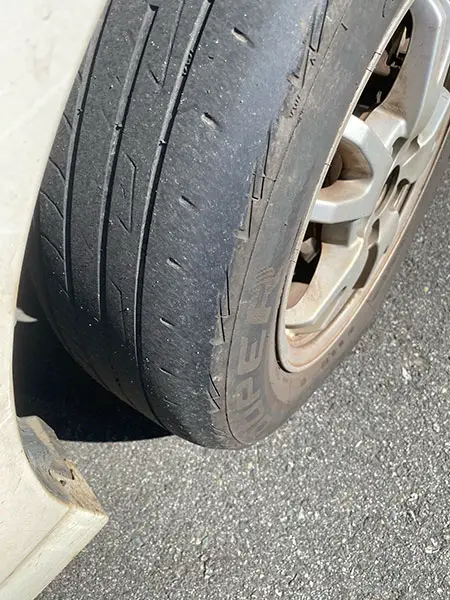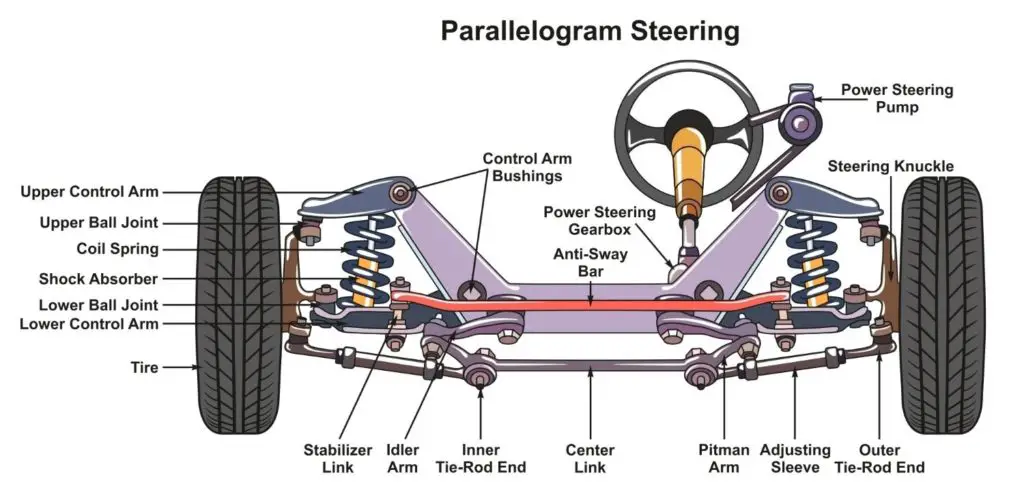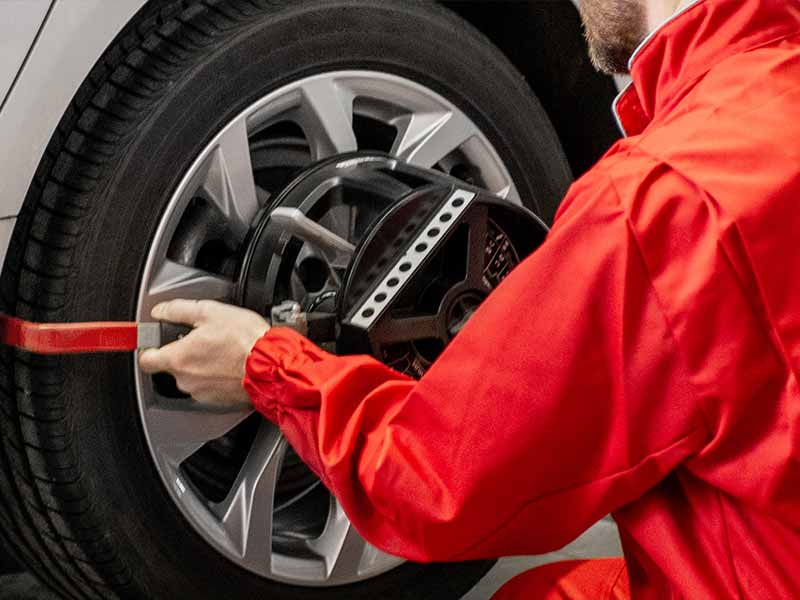Just had your vehicle aligned and scratching your head over the details of the report? You remember your mechanic mentioning something about toe-in and toe-out. But how exactly do these alignment adjustments effect handling and your tires?
Toe-In Vs Toe-Out
Toe-in vs toe-out refer to the angle of a vehicle’s front tires.
Toe-in means the fronts of the tires are closer together than the rears, offering more straight-line stability but less responsiveness in turns.
Toe-out is the opposite, with the front of the tires farther apart, providing sharper turns but less stability in a straight line.
In this article, we will explore the intricacies of toe-in and toe-out, how they affect your vehicle’s handling, symptoms of incorrect alignment, and how toe settings are adjusted.
Let’s take a closer look.
What is Toe?
First off, when we say “toe”, we’re talking about the angle that your front tires make in relation to each other. If you were looking down at your vehicle from above, imagine drawing an imaginary line through the middle of the front and back wheels. This line shows us the direction your tires are pointing.
Toe-In
Now, when we talk about “toe-in”, we mean that the fronts of the tires are angled towards each other, kind of like a pair of pigeon toes. In more technical terms, this is referred to as “positive toe”. It might seem counterintuitive, but having the front tires slightly pointing towards each other can help increase the stability of your vehicle, especially during high-speed straight line driving.
Toe-Out
On the other hand, “toe-out” or “negative toe” is just the opposite. This is when the fronts of the tires are angled away from each other. It’s like your car’s front tires are ready to hug a corner. Toe-out improves your vehicle’s steering response, making it easier to turn corners. This is particularly beneficial for cars that need to make sharp turns at high speeds, like race cars.
Impact on Handling
The toe settings of your car have a significant effect on how your car responds to your steering inputs. If you imagine driving in a straight line, the following might happen:
- With Toe-In: Your car will have enhanced stability. This makes it ideal for straight-line driving or cruising on a highway. However, too much toe-in can make your car feel sluggish when trying to corner or turn.
- With Toe-Out: Your vehicle becomes more responsive to steering input, making it easier to turn or corner. But, watch out – too much toe-out can make your car feel a bit twitchy or unstable in straight lines.

Effects on Tire Wear and Suspension Components
Toe settings can have a substantial impact on the wear and tear of your tires and even your suspension components:
- Toe-In: Can cause the outside edges of your tires to wear out quicker because of the increased rolling resistance. If not corrected in time, this can lead to premature tire replacement.
- Toe-Out: Results in excessive wear on the inside edges of your tires. Like with toe-in, if not corrected in time, this can lead to premature tire replacement.
In addition, incorrect toe settings can put undue stress on your suspension components, leading to more frequent maintenance or replacement of parts.
Straight Line Movement and Rolling Resistance
Your vehicle’s straight-line movement and rolling resistance are influenced by its toe settings:
- Toe-In: Helps maintain straight line stability but increases rolling resistance, which can lower your vehicle’s fuel efficiency.
- Toe-Out: Reduces rolling resistance, potentially improving fuel efficiency, but it can compromise straight line stability.

How Much Toe-In or Toe-Out is Too Much?
While the exact amount can depend on various factors such as the type of vehicle, driving conditions, and personal preferences, here are some general guidelines:
- Passenger Cars and Trucks: For most passenger cars and trucks, a slight amount of toe-in is usually recommended. This generally falls within the range of 1/16 to 1/8 inch. This helps the vehicle maintain straight-line stability and compensate for the natural tendency of the wheels to move outwards while in motion.
- Performance and Race Cars: The settings can vary significantly based on the type of racing and the specific vehicle. For example, a race car driven on a track with lots of twists and turns might benefit from a bit more toe-out for quicker cornering response.
- Drifting Cars: These might have more toe-out in the front to help initiate drifts and some toe-in in the rear for stability during a drift.
Checking for Too Much Toe
How do you know if you have too much toe-in or toe-out? Here are some tell-tale signs:
- Excessive Tire Wear: If you notice uneven wear on the edges of your tires, it could be a sign that your toe settings are off. Too much toe-in can cause wear on the outside edges, while too much toe-out can cause wear on the inside edges.
- Vehicle Pulling to One Side: If your vehicle tends to drift or pull towards one side when you’re driving in a straight line, it might be an indication that your alignment, including toe, is off.
- Poor Handling: If your vehicle feels unstable in straight lines (possible toe-out issue) or sluggish in corners (possible toe-in issue), it could be due to incorrect toe settings.

Recognizing Incorrect Toe-In and Toe-Out Alignment Symptoms
Sometimes things can go off-kilter with your vehicle’s alignment. This can be due to several reasons, from hitting a pothole too hard to simply wear and tear over time.
Symptoms of Incorrect Toe-In Alignment
Toe-in, when set correctly, can improve your vehicle’s stability. But if you’ve got too much, you might start noticing:
- Wear on Outer Edges of Tires: Excessive toe-in can cause premature wear on the outer edges of your tires. So, if you’re seeing more wear on the outside than the inside, it might be time to check your alignment.
- Sluggish Handling: Too much toe-in can cause your vehicle to respond slowly to steering inputs, making it feel less agile, especially when cornering.
- Vehicle Pulling to One Side: If your car seems to drift or pull to one side, it might be due to too much toe-in.
Symptoms of Incorrect Toe-Out Alignment
Toe-out can be beneficial for better steering response, but when it’s too much, it can cause problems:
- Wear on Inner Edges of Tires: Excessive toe-out can cause your front tires to wear faster on the inner edges. If you’re noticing this type of wear, your toe-out might be set too high.
- Vehicle Feels Unstable: If your vehicle feels a bit twitchy, especially when driving in a straight line, it might be a sign of too much toe-out.
- Vehicle Pulling to One Side: Like toe-in, too much toe-out can also make your car drift or pull to one side.
So, how do you avoid these issues?
- Regular Checks: It’s a good idea to inspect your tires regularly for uneven wear. This can help you catch alignment issues early before they lead to more serious problems.
- Professional Alignment: If you’re noticing any of these symptoms, it’s best to take your vehicle to a professional for an alignment check and adjustment. They’ll be able to set the toe (and other alignment settings) correctly for optimal performance and tire longevity.

Toe Angle Adjustment
Making sure your vehicle’s toe angle is set correctly is essential for optimal performance, safety, and tire longevity. But how exactly is the toe angle adjusted, and what role does the steering geometry and the tie rod play? Let’s dig in!
Role of Steering Geometry and Tie Rod in Adjustment
Steering geometry refers to the configuration and alignment of the vehicle’s steering and suspension components. It’s crucial to the car’s handling characteristics, including how it responds to steering inputs.
Here’s where the tie rod comes in:
- Tie Rod: This is a vital part of the steering mechanism in cars and trucks. It’s a rod-like component that connects the steering wheel to the front tires. When you turn the steering wheel, the tie rod pushes or pulls the wheel to make the vehicle turn.
So, how does this relate to toe adjustment?
- Adjusting the Tie Rod: The length of the tie rod can be adjusted. When the length is changed, it alters the angle of the tires relative to the centerline of the vehicle, which is what we refer to as the toe angle.
Importance of the Imaginary Line in Alignment
The “imaginary line” is a key concept in understanding and adjusting vehicle alignment, including the toe angle. But what is it?
- Imaginary Line: This is a hypothetical line drawn through the center of the vehicle, from the front to the back. It’s used as a reference when setting alignment parameters, including the toe.
In relation to toe adjustment:
- Toe-In: If the front of the tires are closer together than the rear (relative to the imaginary line), then the vehicle has toe-in.
- Toe-Out: If the front of the tires are farther apart than the rear (relative to the imaginary line), then the vehicle has toe-out.
Resources
Below are some links you may find helpful when learning about tires
Final Thoughts
Toe-in and toe-out adjustments can make a big difference in how your car or truck responds to your steering inputs, whether you’re cruising down a straight road or negotiating a sharp turn.
Remember, toe-in tends to offer more straight-line stability but can make cornering feel less responsive. On the other hand, toe-out improves the vehicle’s cornering response but may reduce straight-line stability.
Good luck and happy motoring.




